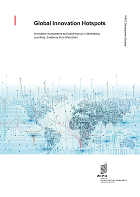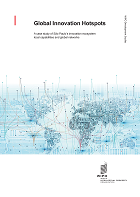Development Studies
We work on a wide range of studies investigating how intellectual property (IP) interacts with economic development.
These studies aim to narrow the knowledge gap decision-makers face when adopting IP policies aimed at supporting broader development objectives.

The Global Gender Gap in Innovation and Creativity: An International Comparison of the Gender Gap in Global Patenting over Two Decades
This report analyzes women’s participation in international patent applications between 1999 and 2020 and finds that women are involved in only 23% of all applications, representing 13% of all inventors listed. Women’s participation in patenting varies across regions, sectors, and industries, with higher representation in biotechnology, food chemistry, and pharmaceuticals, and lower in mechanical engineering. Women inventors are more prevalent in academia than in the private sector, and typically work in mostly-male teams or alone. Achieving gender parity will require significant effort, with an estimated target year of 2061 based on current trends.
Global Innovation Hotspots: Singapore's innovation and entrepreneurship ecosystem
This report consists of two parts. Part A traces the dynamic evolution of Singapore’s innovation and entrepreneurship ecosystem over time and the changing mix of public policies that have shaped that evolution. This part of the report brings the analysis of Singapore’s innovation ecosystem development trends up to the end of 2020. In Part B, we present a more in-depth analysis of the changing pattern of innovation among the key innovation actor groups in Singapore – local enterprises, local universities and public research institutes, and foreign firms with innovation activities in Singapore – using a database of patents granted to inventors in Singapore for the period 2000–2020.
Global Innovation Hotspots: Innovation ecosystems and catching-up in developing countries: Evidence from Shenzhen
Based on international patent and scientific publication data, this report classifies Shenzhen’s technological trajectory and catch-up process into three stages: 1) accessing advanced technology by participating in the Global Production Networks (GPNs) and Global Value Chains (GVCs), 2) accumulating technological knowledge and enhancing absorptive capability through imitation and 3) achieving indigenous innovation. We interpret this remarkable catch-up process from the perspective of 1) technological specialization, 2) the local innovation ecosystem and 3) its embeddedness into the Global Innovation Networks (GINs). The last part summarizes Shenzhen’s policy lessons in fostering innovation-based economic growth in developing countries and areas.
Global Innovation Hotspots: A case study of São Paulo’s innovation ecosystem local capabilities and global networks
This report presents an in-depth study of the innovation ecosystem of São Paulo (Brazil). We use georeferenced patent, scientific publication, and economic data to characterize one of the few global innovation hotspots in Latin America and the southern hemisphere. It attempts to understand what makes São Paulo different from the rest of Brazil and the Latin American region by mapping what its main potentialities and drawbacks are. The report finds that São Paulo is rich in scientific activity, but lags behind with respect to patent production. At the same time, it is a patent leader in Brazil and the region with characteristics resembling the large innovation hotspots of the world. The report also shows where São Paulo is in the global knowledge space, and how it can leverage scientific production and global networks to upgrade into more complex technological activities. The report also reviews the main innovation policies at national and subnational level, which may partially explain the São Paulo’s success story.
Understanding the Use of Industrial Designs in ASEAN Countries: National report for Thailand
This report presents the results of an industrial design (ID) survey study carried out in three ASEAN countries, namely Thailand. It was prepared for the Project on Intellectual Property (IP) and Socio-Economic Development – Phase II, which aims to provide a better understanding of the role IDs play in business strategies, how ID rights contribute to the appropriation of investments in design innovation, and what challenges applicants face when using ID rights.
Understanding the Use of Industrial Designs in ASEAN Countries: National report for Philippines
This report presents the results of an industrial design (ID) survey study carried out in three ASEAN countries, namely Philippines. It was prepared for the Project on Intellectual Property (IP) and Socio-Economic Development – Phase II, which aims to provide a better understanding of the role IDs play in business strategies, how ID rights contribute to the appropriation of investments in design innovation, and what challenges applicants face when using ID rights.
Understanding the Use of Industrial Designs in ASEAN Countries: National report for Indonesia
This report presents the results of an industrial design (ID) survey study carried out in three ASEAN countries, namely Indonesia. It was prepared for the Project on Intellectual Property (IP) and Socio-Economic Development – Phase II, which aims to provide a better understanding of the role IDs play in business strategies, how ID rights contribute to the appropriation of investments in design innovation, and what challenges applicants face when using ID rights.
WIPO-ASEAN Design Manual
This document is a manual which provides the technical detail of the survey questionnaire designed and implemented for the study on “Understanding the Use of Industrial Designs –the Case of Indonesia, Philippines and Thailand.” It was prepared for the Project on Intellectual Property (IP) and Socio-Economic Development – Phase II, which aims to provide a better understanding of the role IDs play in business strategies in specific ASEAN Countries, and is designed to help and guide other researchers who wish to carry out a similar study in their countries of interest. The steps undertaken to mitigate the challenges and the lessons learned will hopefully inform researchers on their own endeavors.





